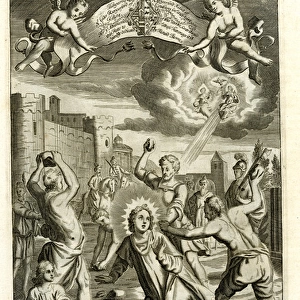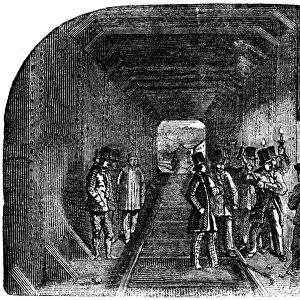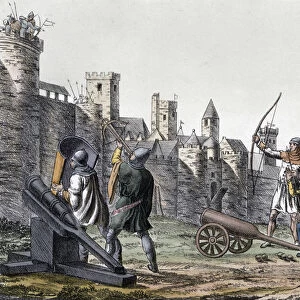Fine Art Print > Europe > Spain > Related Images
Fine Art Print : Maya calendar, diagram
![]()

Fine Art Prints from Science Photo Library
Maya calendar, diagram
Maya calendar. Diagram showing how one particular Maya calendar was based on a cyclic combination of 13 numbers (smaller wheel) and twenty day symbols (larger wheel) to produce a calendar that is 260 days long (large wheel partially seen at right). This is known as the Tzolk in calendar. The Maya were an ancient Mesoamerican civilization that inhabited southern Mexico and nearby areas for thousands of years from the second millennium BC to the Spanish conquest in the 16th century. The Maya had advanced astronomical knowledge and could predict solar and planetary events
Science Photo Library features Science and Medical images including photos and illustrations
Media ID 6321311
© This illustration is protected by laws and international treaties, as well as other intellectual property laws and treaties
Calendar Central America Central American Chronometry Cycle Cycles Diagram Mathematical Mathematics Mayan Mesoamerican Mexican Mexico North American Period Periodic Periods South America South American Symbol Symbology Symbols Temporal Time Year Maya Pre Columbian
21"x14" (+3" Border) Fine Art Print
Discover the intriguing world of the ancient Maya civilization with our exquisite range of Fine Art Prints. This captivating image, captured by Claus Lunau from Science Photo Library, showcases the intricate design of the Maya calendar. A harmonious blend of mathematics and astronomy, the calendar consisted of a 13-numbered smaller wheel and a 20-day symbol larger wheel, cycling endlessly through the cosmos. Bring the mysteries of this ancient culture into your home or office with our museum-quality prints, meticulously crafted to bring out the rich colors and details of this diagram. Each print is a work of art in itself, adding an element of intrigue and sophistication to any space.
21x14 image printed on 27x20 Fine Art Rag Paper with 3" (76mm) white border. Our Fine Art Prints are printed on 300gsm 100% acid free, PH neutral paper with archival properties. This printing method is used by museums and art collections to exhibit photographs and art reproductions.
Our fine art prints are high-quality prints made using a paper called Photo Rag. This 100% cotton rag fibre paper is known for its exceptional image sharpness, rich colors, and high level of detail, making it a popular choice for professional photographers and artists. Photo rag paper is our clear recommendation for a fine art paper print. If you can afford to spend more on a higher quality paper, then Photo Rag is our clear recommendation for a fine art paper print.
Estimated Image Size (if not cropped) is 53.3cm x 27.9cm (21" x 11")
Estimated Product Size is 68.6cm x 50.8cm (27" x 20")
These are individually made so all sizes are approximate
Artwork printed orientated as per the preview above, with landscape (horizontal) orientation to match the source image.
FEATURES IN THESE COLLECTIONS
> Europe
> Spain
> Related Images
> South America
> Related Images
EDITORS COMMENTS
This print showcases a remarkable piece of ancient history - the Maya calendar. The intricate diagram reveals the ingenious system employed by the Maya civilization to track time and celestial events. At its core, this particular calendar is based on a cyclic combination of 13 numbers represented by a smaller wheel, and twenty day symbols depicted on a larger wheel. Together, these elements produce a unique calendar that spans 260 days. The Maya people were an advanced Mesoamerican civilization who thrived in southern Mexico and neighboring regions for thousands of years until the Spanish conquest in the 16th century. Renowned for their astronomical knowledge, they possessed an extraordinary ability to predict solar and planetary phenomena. This illustration not only highlights their mathematical prowess but also serves as a testament to their cultural significance. It symbolizes the temporal nature of existence while embodying the rich history and heritage of pre-Columbian civilizations. As we delve into this mesmerizing artwork from Claus Lunau's collection, we are transported back in time to witness the brilliance of Mayan chronometry unfold before our eyes. Let us marvel at how these ancient peoples harnessed their understanding of cycles, periods, and symbols to create such an intricate calendrical system that continues to captivate scholars and enthusiasts alike today.
MADE IN AUSTRALIA
Safe Shipping with 30 Day Money Back Guarantee
FREE PERSONALISATION*
We are proud to offer a range of customisation features including Personalised Captions, Color Filters and Picture Zoom Tools
SECURE PAYMENTS
We happily accept a wide range of payment options so you can pay for the things you need in the way that is most convenient for you
* Options may vary by product and licensing agreement. Zoomed Pictures can be adjusted in the Cart.















